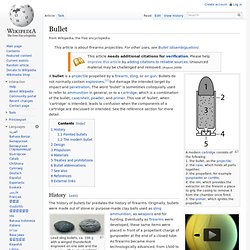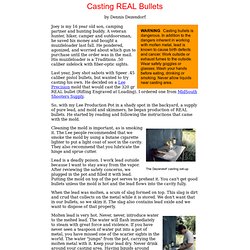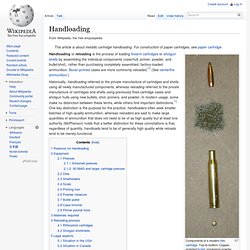

Bullet. Schlieren image of a bullet travelling in free-flight demonstrating the air pressure dynamics surrounding the bullet.

History[edit] Lead sling bullets, ca. 100 g with a winged thunderbolt engraved on one side and the inscription "Take that" (ΔΕΞΑΙ) on the other side. Athens, 4th century BC. Matchlock musket balls, alleged to have been discovered at Naseby battlefield. The first half of the nineteenth century saw a distinct change in the shape and function of the bullet. Square bullets, invented by James Puckle and Kyle Tunis, were briefly used in one version of the Puckle gun. Pointed bullets[edit] Among the first pointed or "conical" bullets were those designed by Captain John Norton of the British Army in 1823. Casting REAL Bullets. Joey is my 16 year old son, camping partner and hunting buddy.

A veteran hunter, hiker, camper and outdoorsman, he saved his money and bought a muzzleloader last fall. He pondered, agonized, and worried about which gun to purchase until the order was in the mail. His muzzleloader is a Traditions .50 caliber sidelock with fiber-optic sights. Last year, Joey shot sabots with Speer .45 caliber pistol bullets, but wanted to try casting his own.
He decided on a Lee Precision mold that would cast the 320 gr REAL bullet (Rifling Engraved at Loading). Tacticool Products - Bullet Casting. Bullet Casting Introduction Shooters usually start reloading because we're motivated by saving money but quickly learn that reloading is an interesting and worthwhile hobby in its own right.

Reloaders experience pride in loading their own ammunition. Similarly, many reloaders start casting their own lead bullets because they want to save money, only to find that bullet casting is an interesting and enjoyable hobby as well. Casting your own lead bullets adds another source of pride to reloading ammunition, and offers yet another level of control over the ammunition you shoot, providing more opportunities to develop custom loads optimized to your gun and your shooting needs. Cast lead bullets are surprisingly accurate, and while most people cast bullets in large volume for use in pistols, lead bullets are very accurate in rifles as well, and harder lead bullets can be shot at reasonable rifle velocities without excessive bore leading.
Equipment And Materials. Cast bullet. Cast bullets as cast (left), with gas check (center) and lubricated (right).

History[edit] The earliest cast bullets were round. Firearms projectiles were being cast in the 14th century. Iron was used for cannon, while lead was the preferred material for small arms. Lead was more expensive than iron, but it was softer and less damaging to the relatively weak iron barrels of early muskets. Swaging, rather than casting, became a preferred manufacturing technique during the 19th century industrial revolution; but lead bullets remained popular in early rimmed black powder cartridges like the .32-20 Winchester, .32-40 Ballard, .38-40 Winchester, .38-55 Winchester, .44-40 Winchester, .45 Colt, and .45-70. Cast bullet advantages[edit] An open single-cavity bullet mould and a closed two-cavity mould.
Bullet casting remained popular for shooters accustomed to older weapons. These basic advantages remain true today. Safety[edit] Bullet shapes[edit] Gas checks[edit] Bullet alloys[edit] Heat treating[edit] Welcome to The Reload Bench. RCBS - Precisioneered Shooting Products - Products. Reloading - Brass - Projectiles - Reloading Dies - Moulds & Casting - Case Preparation - Brass - RELOADING. Inherently, reloading ammunition is dangerous.

The application of a little common sense will go a long way in keeping you out of trouble. As usual, with any reloading data, the components and charge weights used here were safe in the rifles they were tested in, and any change of components could result in dangerous pressure. So, please, if you are new to reloading, go out and buy one of the many excellent reloading manuals that are available. Handloading. Historically, handloading referred to the private manufacture of cartridges and shells using all newly manufactured components, whereas reloading referred to the private manufacture of cartridges and shells using previously fired cartridge cases and shotgun hulls using new bullets, shot, primers, and powder.

In modern usage, some make no distinction between these terms, while others find important distinctions.[1] One key distinction is the purpose for the practice; handloaders often seek smaller batches of high-quality ammunition, whereas reloaders are said to make large quantities of ammunition that does not need to be of as high quality but at least one authority (McPherson) holds that a better distinction for these connotations is that, regardless of quantity, handloads tend to be of generally high quality while reloads tend to be merely functional. Reasons for handloading[edit] Recurring shortages of commercial ammunition are also reasons to reload cartridges and shotshells.